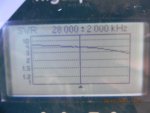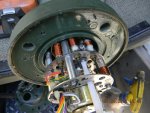Here are some test results on the AS-3900A/VRC antenna and the AS-1729/VRC with the goal of using the antennas on CB or ham radio in a plug-and-play way.
The 3900 is a later model that we recognize by having only a BNC coaxial connector on the bottom. The AS-3900 spec sheets may be found online.
The earlier model AS-1729 base has the BNC coaxial connector, a manual ‘band’ switch, and a multi-conductor jack for the control cable. No control cable is required to use this antenna if you set the switch manually.
The 3900 was designed for frequency hopping around the 30-88 MHz range so it must present a reasonably low reflected power (low SWR) across the entire tactical radio range. That is a tremendous challenge and is accomplished by emulating a 50 Ohm dummy load, but allowing some radiation! Look at the Gain, an actual ‘loss’ of -7.6 dB at 30 MHz, and we want to use it at an even lower frequency below design frequency, where it is worse. However, this is a plug-and-play antenna which will work with no effort.
How well will the AS-3900 work? The antenna analyzer sweep shows around 4:1 SWR. The radio will probably handle 4:1 SWR, being made to work with some horrible antennas and coaxial connections. How much power will be transmitted? For every 3 dB of loss (negative gain), lose half the power. Also lose power if the radio folds back output power to protect itself. The antenna gain number is published at greater that MINUS 7 dB. With 5 Watts out from the transmitter, expect about 1 Watt out of the antenna. Sure it will work. One Watt will talk a long way on CB, but only line of sight plus a little.
So what does the performance look like for these antennas for CB, outside the design spec? Below is the scan I did for the AS-3900. This is a new AS-3900 mounted on a typical mount on the right upper cab of an LMTV. Scan runs from 26 to 30 MHz to cover the 10 meter ham band and CB frequencies. The CB band is around 27 MHz.
Remember that a 50 Ohm ‘dummy load’ termination would have very good SWR but not radiate at all. The 3900 is better than a dummy load. [insert your HA HA here]

The AS-1729/VRC is a more adaptable antenna, but is it actually more usable? It was designed back when the channelized radio would be set on one frequency, so the antenna would be tuned to that frequency. The manual switch on the 1729 lets us set the band to approximate the right conditions.
This is important; the gain on the AS-1729 is spec'ed at -1dB to + 4dBi. So whatever power we get into the antenna can actually be transmitted (well, with a little loss on the low end of the spec). Actual gain can occur in parts of the range.
On CB frequencies the AS-1729 is as much as 4 MHz below its lowest ‘tuned’ band, and exhibits SWR of from about 8:1 to 10:1 SWR. That’s bad. Remember that this is actually measured value. Not many radios, CB or Ham, would operate into this high SWR without cutting back on output power, or just failing.
An interesting fringe benefit of the 1729 is that the antenna will actually resonate (approach 50 Ohm resistive load) on frequencies other than the numbers on the switch.
By the way, the AS-1729 can be tuned inside the housing. No doubt the antenna can be tuned to adjust performance to preferred frequencies within each band. Here’s what it looks like inside. The coils are tunable. I did not make any attempt to tune the antenna knowing most people want to plug and play.

I went through the bands looking for bonus resonant frequencies, and testing specifically on CB, 10 meter Amateur, and 6 meter Amateur. There were some surprises.
Note that none of the intended Military frequencies were tested for performance. Few of us care how the antenna works on the military frequencies.
Antenna tests;
On the 30-33 position that we might expect to work best on CB:
26.5 MHz on CB shows 8.2 SWR, low end of the band. This is BAD swr on CB.
27.185 MHz almost 10:1 SWR, this is channel 19 CB, horrible
27.5 MHz 9:1 SWR upper end CB, just as horrible.
21.5 MHz shows1.5 SWR surprise use on 15m Amateur?
That is terrible performance on CB. But it could still work. The radio will protect itself (or it won’t) and some signal will get out. Use at your own risk.
This 30-33 MHz band switch positon is usable in a narrow portion of the 15 meter band but not useful on 10 meter or 6 meter band.
---
All the switch positions were tested in the order they are presented on the AS-1729’s switch. To keep this info within a reasonable size only the most useful data is summarized.
42-47.5 MHz: Usable at the top of 15m. On channel 19 the SWR is 5:1. 52.525 MHz is 4:1 (6 meter National FM calling frequency.
47.5-53 MHz: on channel 19 CB the SWR is about 3:1. Might work fine. 52.525 about 4;1 SWR. This is the band to select for 6 meters. 4:1 is quite high. Note the 6m performance on the 70.5-76 band.
37-42 MHZ: no usable resonances
33-37 MHz: CB band over 7;1 SWR. 21.350 mhz on 15 m has SWR of about 1.3, usable.
53-56 MHz: CB band SWR over 5:1.
66-70.5 MHz: CB band SWR is about 5:1.
70.5-76 MHz: CB has very high SWR >9:1. Usable on 6 meter band: 52.525 MHz has SWR of 2.7:1. Low end of 15 meters 21 MHz is about 2.2:1 SWR, but narrow.
60-85 MHz: nothing usable
56-60 MHz: nothing usable.
So what is the bottom line?
The AS-3900 is the easiest for a plug and play operation on CB. It may not put out much power but will not hurt the radio.
The AS-1729 has the potential of being a good CB (or ham) antenna WITH GAIN, but without some additional matching just might hurt the radio (10:1 SWR).



